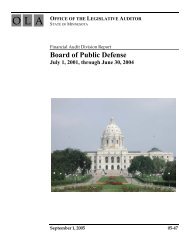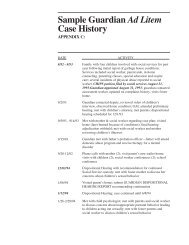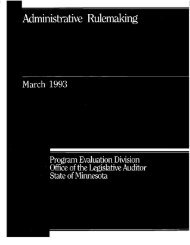Occupational Regulation - Office of the Legislative Auditor
Occupational Regulation - Office of the Legislative Auditor
Occupational Regulation - Office of the Legislative Auditor
Create successful ePaper yourself
Turn your PDF publications into a flip-book with our unique Google optimized e-Paper software.
SUMMARY<br />
Across <strong>the</strong><br />
country, several<br />
important<br />
legislative<br />
reforms have<br />
been prompted<br />
by concern<br />
about<br />
occupational<br />
regulation.<br />
Two legislative reforms with particular application to occupational regulation are<br />
known as “sunrise” and “sunset.” In 1976, Minnesota became one <strong>of</strong> <strong>the</strong> first<br />
states to pass sunrise legislation when it amended Minnesota Statutes Chapter 214<br />
to include criteria for occupational regulation against which any new or increased<br />
regulation were to be judged. The regulatory policy articulated by Chapter 214<br />
recognizes <strong>the</strong> potential danger <strong>of</strong> occupational fencing and challenges proponents<br />
<strong>of</strong> regulation to demonstrate that regulation serves <strong>the</strong> public interest.<br />
Sunset legislation mandates periodic reviews <strong>of</strong> regulatory programs in order for<br />
<strong>the</strong>m to continue past a specified date. Sunset has not resulted in <strong>the</strong> widespread<br />
success which it once seemed to promise, and has never been a regular part <strong>of</strong><br />
occupational regulation in Minnesota, but several authorities continue to call for<br />
<strong>the</strong> implementation <strong>of</strong> sunset reviews to improve legislative oversight and to<br />
eliminate regulatory programs that have become outdated.<br />
The 1976 amendments to Chapter 214 also defined an active role for <strong>the</strong><br />
Minnesota Department <strong>of</strong> Health in studying proposals for new regulation <strong>of</strong><br />
health pr<strong>of</strong>essions. It established <strong>the</strong> Human Services Occupations Advisory<br />
Council (HSOAC) to advise <strong>the</strong> Commissioner <strong>of</strong> Health on regulatory policy.<br />
The Council conducted 11 studies between 1976 and 1982, and 13 studies<br />
between 1984 and 1990. The 1976 amendments authorized <strong>the</strong> department to<br />
enact “title protection,” a form <strong>of</strong> occupational regulation, through administrative<br />
rulemaking; and a number <strong>of</strong> HSOAC studies recommended title protection to <strong>the</strong><br />
Commissioner. 4 O<strong>the</strong>r sunrise studies recommended licensure to <strong>the</strong> Legislature.<br />
Still o<strong>the</strong>rs recommended no regulation.<br />
xi<br />
There have been several executive branch and legislative studies <strong>of</strong> occupational<br />
regulation over <strong>the</strong> years. In <strong>the</strong> mid-1970s <strong>the</strong> Department <strong>of</strong> Administration<br />
conducted a major study and published reports in 1976 and 1977. Among o<strong>the</strong>r<br />
things, <strong>the</strong> department recommended replacing all autonomous regulatory boards<br />
with advisory boards housed in various state departments. Following <strong>the</strong> study, a<br />
Senate Government Operations Committee task force on occupational regulation<br />
was established to follow up on <strong>the</strong> report’s recommendations. The task force did<br />
not agree with <strong>the</strong> suggestion that <strong>the</strong> independent boards be abolished, although<br />
it recommended streng<strong>the</strong>ning <strong>the</strong> relationship between boards and host<br />
departments that provided administrative services. Over <strong>the</strong> years, however, <strong>the</strong><br />
relationship between boards and host agencies has become attenuated ra<strong>the</strong>r than<br />
streng<strong>the</strong>ned, especially for <strong>the</strong> boards affiliated with <strong>the</strong> Minnesota Department<br />
<strong>of</strong> Health. Copying and data processing, a major concern in <strong>the</strong> Department <strong>of</strong><br />
Administration report, have become less expensive in <strong>the</strong> last 20 years and <strong>the</strong><br />
economies available from centralization <strong>of</strong> <strong>the</strong>se services have greatly diminished<br />
or vanished altoge<strong>the</strong>r.<br />
In <strong>the</strong> 1990s, <strong>the</strong>re have been two interim committees <strong>of</strong> <strong>the</strong> Legislature, one in<br />
<strong>the</strong> House and one in <strong>the</strong> Senate, that studied <strong>the</strong> issue <strong>of</strong> occupational regulation<br />
4 Title protection restricts <strong>the</strong> use <strong>of</strong> a title, such as “athletic trainer,” to those who are credentialled<br />
by <strong>the</strong> state, but does not prohibit o<strong>the</strong>rs from providing <strong>the</strong> same services if <strong>the</strong>y use a different<br />
title. Minnesota law refers to this type <strong>of</strong> credential as registration, but <strong>the</strong> nationally used<br />
term for title protection is “certification.”








